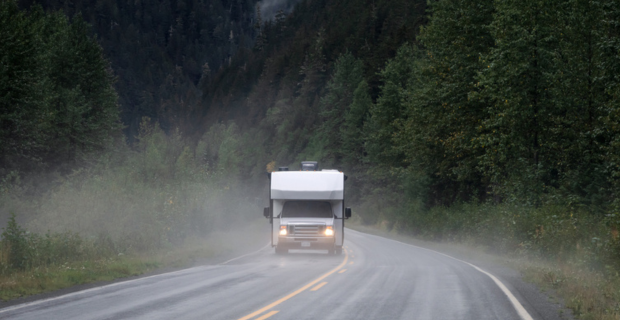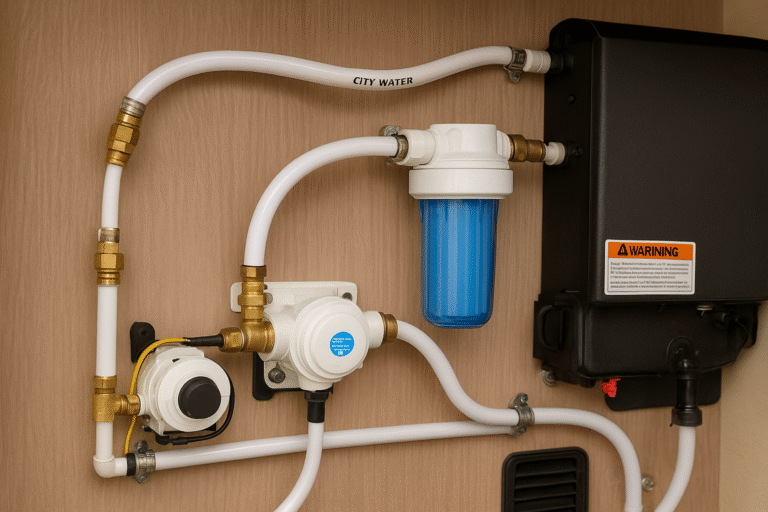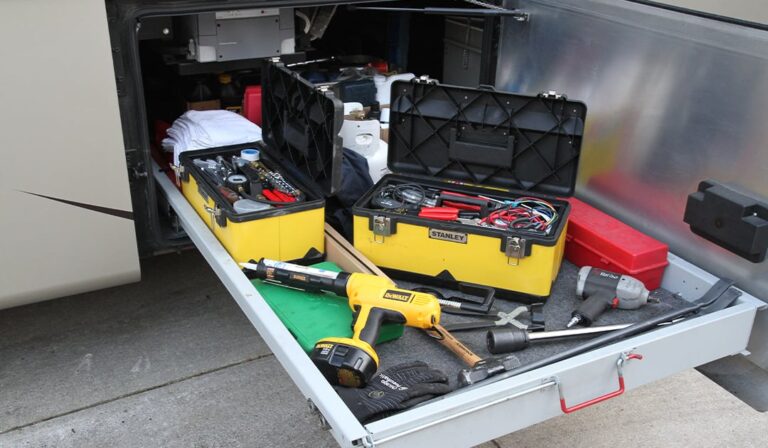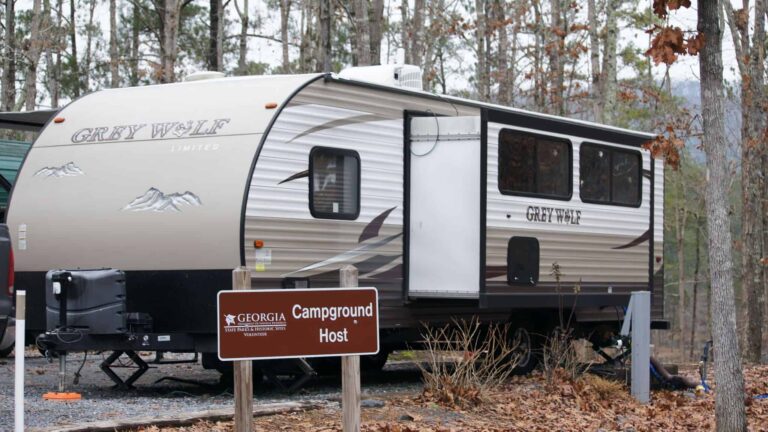How to Handle Extreme Weather in an RV – A Practical Guide for RVers
Whether you’re crossing the Rockies in Canada or chasing sunshine across Arizona, every RVer knows that Mother Nature doesn’t always play nice. From freezing blizzards and hurricane remnants to record-breaking heat waves, the weather can turn an RV dream into a roadside nightmare if you’re unprepared. Learning how to handle extreme weather in your RV isn’t just about comfort-it’s about safety, cost-efficiency, and trip longevity.
According to Camper Champ’s 2024 North American Camping Report, more than 87 million people camped in North America last year, and nearly 47% used RVs as their main mode of travel. With climate patterns becoming more unpredictable, more RVers are facing the challenge of adapting to fluctuating temperatures- from -30°F winters in Alberta to 115°F desert days in Nevada.
This guide breaks down practical RV extreme weather tips, setups, and data-driven insights to help you stay safe and comfortable in any climate.
Why Preparing for Extreme Weather Matters
Climate data from the U.S. National Oceanic and Atmospheric Administration (NOAA) shows that heat-related weather events have doubled in the last 40 years, and winter storms are also increasing in severity across the Midwest and Canada. RV owners, unlike home dwellers, rely on thinner insulation, compact heating systems, and exposed water lines—making preparedness essential for both convenience and survival.
Failing to plan for severe weather can lead to:
- Frozen water lines or cracked tanks in cold spells.
- Overheated interiors and damaged batteries in excessive heat.
- Roof damage and leaks from hail or wind storms.
- Unsafe driving conditions and loss of traction.
Common extreme events that affect RVers in the US and Canada
- Heat waves and extreme heat – deserts, southwest, prairies and urban areas.
- Wildfires and smoke – Western U.S., British Columbia, Alberta and prairie provinces.
- Hurricanes and tropical storms – U.S. East and Gulf coasts, Atlantic Canada.
- Tornadoes and severe thunderstorms – U.S. Plains, Midwest and parts of Canada.
- Flooding and flash floods – mountain drainages, coastal storm surge, heavy-rain areas.
- Winter storms, ice and blizzards – northern U.S., Canada and mountain passes.
Each hazard needs different preparation. Below are clear, actionable steps you can incorporate into your RV lifestyle.
Extreme Weather RV Preparedness – Key Steps
This section lays out the core plan every RVer should have. Use these steps before you leave, while traveling, and when arriving at a campsite.
1. Plan routes and nightly stops with weather in mind
- Check forecast trends for the region you’ll be in for the entire trip, not just today. Use NWS, Environment Canada and local park alerts.
- Avoid low-lying flood-prone campgrounds when heavy rains are forecast; avoid valley floors during extreme heat if possible.
- When traveling toward hurricane season, keep westbound escape routes and inland shelter options mapped out.
2. Build a realistic emergency kit specific to RV living
See the “RV emergency gear” table below. Aim for 72-hour self-sufficiency for passengers and pets – water, food, first-aid, and means of communication. Store essentials in waterproof bins.
3. Register for local alerts and monitor multiple sources
- In the U.S., sign up for NWS alerts and local county emergency texts.
- In Canada, get WeatherCAN alerts and provincial wildfire/evacuation notices.
- Use at least two weather apps + NOAA/NWS and one local source to avoid single-app failures.
4. Make a simple, practiced evacuation plan
- Identify the nearest solid structure or community shelter at every stop. RV parks sometimes have storm shelters or staff evacuation plans – ask on check-in.
- Practice “drop everything” drills so you can disconnect and go within 15–30 minutes if needed.
5. Know the limits of your RV as shelter
- RVs are not safe during tornadoes, hurricanes or major thunderstorms – move to a building or community shelter. For flash floods, do not stay in a low-lying RV. For extreme heat, a parked RV with no power can quickly become dangerous; have alternatives

RV Extreme Weather Tips: Cold Climates
1. Insulate and Heat-Proof the Interior
Winter camping- sometimes called “four-season RVing”- is growing quickly. In 2023/24, 79% of winter campers in North America used RVs instead of tents or cabins. Proper insulation can save propane, prevent freezing, and keep your interior livable.
Tips to improve insulation:
- Add foam board insulation or reflective panels behind cabinets and walls.
- Use thermal curtains or window film to keep out drafts.
- Install heated water hoses and tank heating pads to prevent frozen systems.
- Keep cabinet doors open on cold nights to allow warm air to circulate to plumbing.
2. Choose Campgrounds Wisely
Target RV parks with winter-rated facilities– many in the northern U.S. and Canada (like Banff National Park or Vermont’s Smugglers’ Notch) offer heated service buildings and snow management. Use RV park directories or KOA winter maps to identify options that remain open with access to plowed roads and power hookups.
3. Manage Propane and Electric Heating
Cold weather RVing means heavy fuel consumption. On average, RVers burn about 1 gallon of propane per day per 20 feet of RV length when heating continuously. To optimize energy:
- Carry two propane tanks.
- Supplement heat with electric space heaters when connected to shore power.
- Use heated mattress pads or 12V blankets for energy-efficient warmth.
RV Extreme Weather Tips: Hot Climates
When temperatures climb over 100°F, your RV can easily turn into a rolling oven. More than 28% of campers across North America now camp year-round, including peak summer months. Protecting your systems in the heat means managing both vehicle performance and personal comfort.
1. Shade and Ventilation
Park strategically: Position your RV under natural shade when possible and orient it so that large window areas face north. Use awning extensions to reduce solar heat gain. Running vent fans in “out” mode helps vent hot air- combine with slightly open windows on the shady side for cross-flow.
2. Upgrade Cooling Efficiency
Ensure your AC filters and coils are clean, as dirty filters can cut cooling performance by up to 30%. Consider supplementary cooling:
- Reflective insulation panels for skylights.
- Portable evaporative coolers (ideal in dry climates).
- Reflective roof coatings to minimize heat absorption.
A case study from Texas RV parks showed that RVers using reflective roof paint reduced interior temperature by up to 14°F during midday peaks.
3. Protect Tires and Electrical Systems
Tire blowouts are common in extreme heat. Check pressure early each morning when tires are cool. High cabin temperatures also degrade lithium-ion batteries, so ensure proper ventilation in your battery compartment. If your system consistently hits over 120°F, use insulated battery wraps or vents.
Preparing for Storms, Floods, and Wind
Hurricanes, lightning, and microbursts can hit unexpectedly- especially in Florida, the Gulf Coast, and the Canadian Maritimes. According to RecWorld RV’s safety report, strong winds and flooding account for over 22% of annual RV insurance claims in storm-prone regions.
1. Before the Storm
- Check weather alerts through NOAA or Environment Canada.
- Anchor the awning and retract slide-outs before winds exceed 25 mph.
- Park with the front of your RV facing into the wind for stability.
- Avoid parking near trees, power poles, or in flood basins.
2. During the Storm
If sheltering in place:
- Fill freshwater tanks but empty gray/black tanks before the storm.
- Close propane valves and switch to battery power in lightning events.
- Stay inside, away from windows.
If evacuation is required:
- Know at least two exit routes from your campground.
- Keep a 72-hour emergency kit: flashlights, first aid, tools, food, blankets, and a secondary power bank.
3. Afterward
Inspect seals, roof coatings, and awnings before continuing travel. Document any damage for insurance immediately.
Essential RV Weather-Proofing Investments
Here’s a summary of gear and upgrades worth considering if you RV in diverse climates.
| Equipment | Recommended Use | Estimated Cost | Notes |
|---|---|---|---|
| Insulated skirting | Cold climates | $800–$2,500 | Reduces heat loss by up to 25%. |
| Reflective window covers | Hot or cold | $100–$300 | Quick to install, reusable. |
| Roof sealant | All-weather | $40–$100 per gallon | Prevents leaks and UV cracks. |
| Portable generator | Storm backup | $600–$2,000 | For off-grid or power loss conditions. |
| Weather radio | Safety | $30–$80 | NOAA-certified alerts helpful when off-grid. |
Data Snapshot: RV Travel and Weather Exposure
| Statistic | United States | Canada |
|---|---|---|
| Average RV camping nights per year | 5.4 nights | 4.7 nights |
| Winter RV camping participation | 24% | 31% |
| RV unit ownership (2023) | 11.2 million | 2.4 million |
| Common weather risk zone | Tornado belt, deserts | Snow belts, coastal storms |
| Top destinations impacted by weather | Texas, Florida, Arizona | Alberta, British Columbia, Nova Scotia |
Sources: RVIA Market Report 2025, Camper Champ 2024, Environment Canada Climate Data
Driving Tips for Harsh Conditions
- Snow and Ice: Carry snow chains and always align tire pressure to cold conditions.
- Wind Gusts: For winds above 35 mph, reduce speed to under 45 mph; if over 50 mph, stop completely.
- Flooded Roads: Avoid driving through water deeper than 6 inches. Even small currents can destabilize RVs.
- Heat: Plan midday driving breaks to avoid peak thermal stress on engines.
These small adjustments can make a major difference in fuel use and repair costs. For instance, keeping tire pressure optimized improves fuel economy by 3% to 5%, according to the U.S. Department of Energy.
Real RVers’ Experiences
In January 2024, a couple traveling from Montana to Banff reported temperatures dropping to -27°F. Their heated freshwater hose and underbelly heaters prevented any freeze damage, while unprepared travelers nearby suffered broken valves and $1,000 in damage.
In contrast, full-timers traveling across Arizona’s Sonoran Desert faced 115°F heat waves. By adding reflective solar shades and LED fans, they reduced interior heat by 10°F and avoided generator overuse.
These firsthand examples highlight an important truth: preparation pays off in comfort, safety, and cost savings.
Insurance and Maintenance Considerations
Weather damage ranks among the top three RV insurance claims in both the U.S. and Canada. Many providers (like Progressive and Good Sam) now offer comprehensive weather protection riders, covering hail, lightning, and flood damage. Before you sign your next policy, ask:
- Does my plan include act-of-nature coverage?
- Are there exclusions for full-time RV living?
- How are roof leaks or frozen pipes handled?
Maintenance-wise:
- Inspect seals every 3-4 months.
- Test carbon monoxide and propane detectors monthly.
- Replace worn window gaskets annually.
These simple checks can prevent thousands in repairs and keep your RV weather-rated for years.
Sustainable Weather Management
Eco-conscious RVers often face a paradox—balancing comfort with sustainability. Here’s how to adapt:
- Use solar panels and lithium batteries instead of relying on fossil generators.
- Choose biodegradable antifreeze and propane-efficient heaters.
- Collect rainwater (where allowed) for non-potable uses.
In 2024, an estimated 59% of private campgrounds in North America added sustainable features like solar energy and recycling points.
Final Thoughts
Extreme weather doesn’t have to mean extreme risk. Whether navigating icy highways in Alberta or summer humidity in Florida, preparation is everything. With the right upgrades, awareness, and safe habits, RVers can turn potential hazards into memorable adventures.
RVers today are more resilient and connected than ever- armed with apps, improved equipment, and growing experience. As North American travel expands, learning to manage climate extremes is key not only for safety but also for protecting the freedom that draws people to the open road in the first place.







